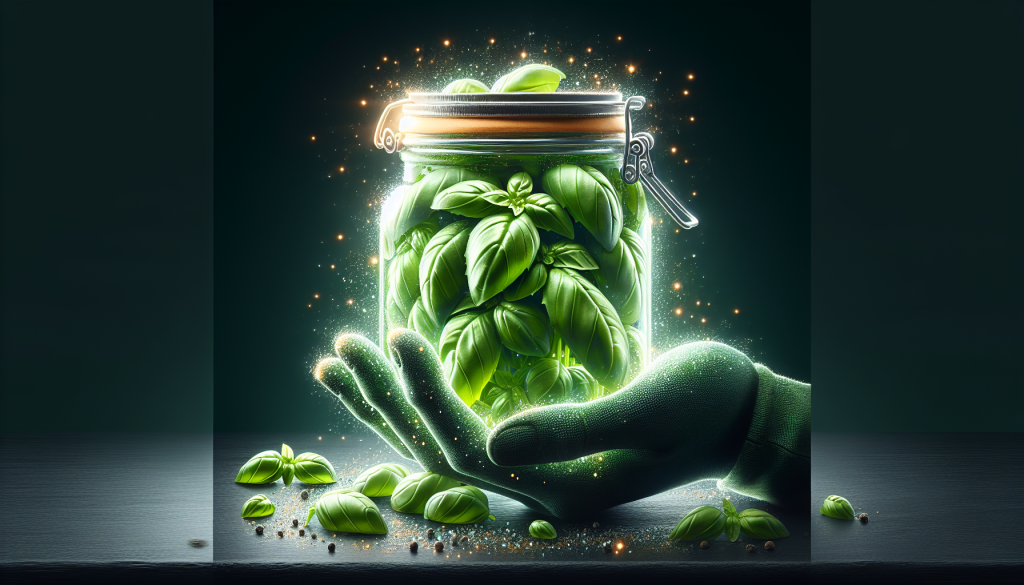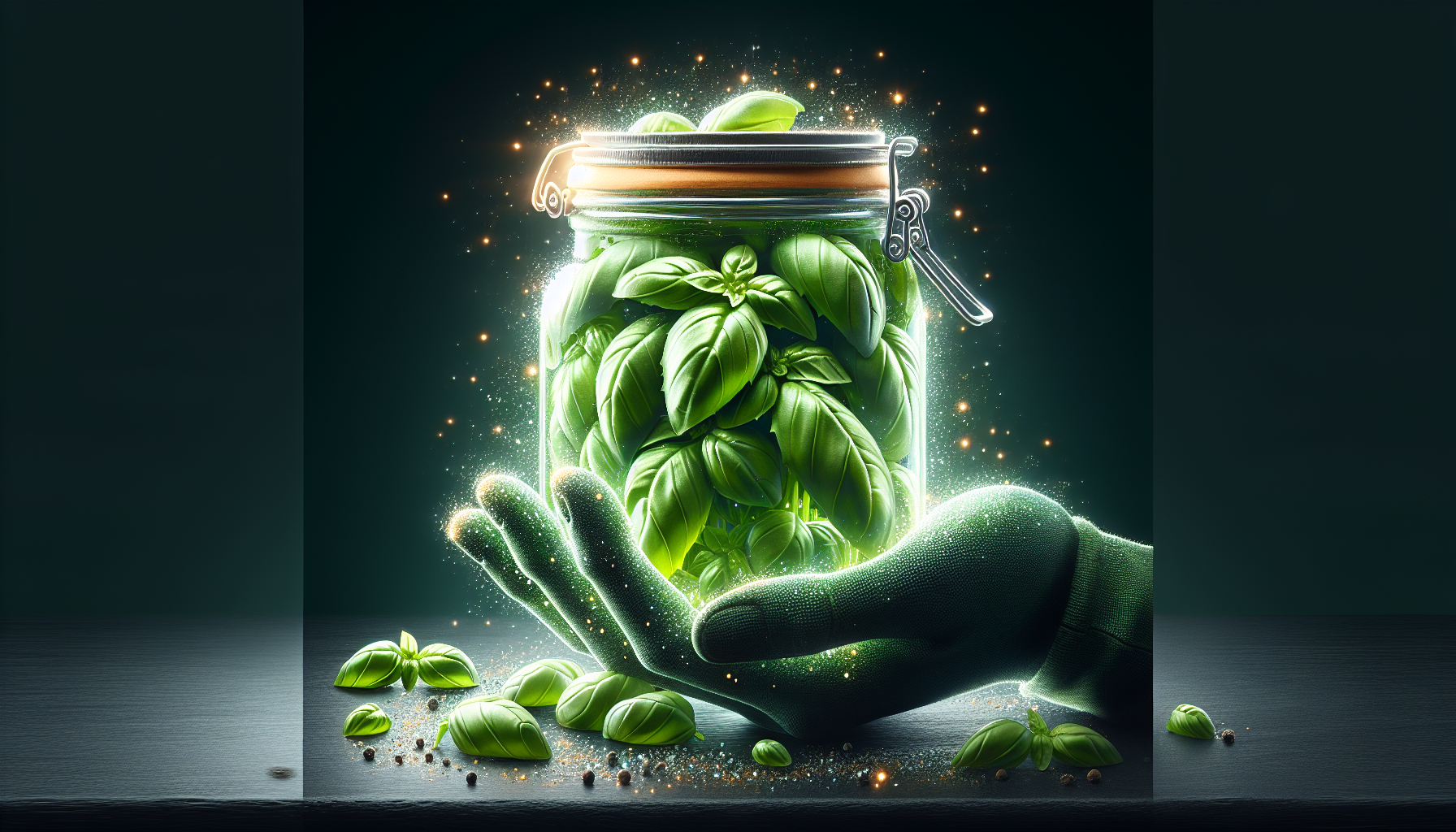If you’re an avid cook or just love the vibrant flavors of fresh herbs, then learning how to freeze basil is a game-changer. This aromatic and versatile herb is a staple in many cuisines, from Italian to Thai, and knowing how to preserve its vibrant taste and aroma can take your culinary creations to the next level. Whether you have an abundant crop of basil from your garden or picked up a bunch from the farmer’s market, this article will guide you through the simple steps of freezing basil to ensure you always have this fragrant herb at your fingertips.
Harvesting Basil for Freezing
Choosing the Right Time to Harvest
When it comes to harvesting basil for freezing, timing is crucial. You want to pick your basil leaves at the peak of their freshness and flavor. The best time to harvest basil is in the morning when the leaves are at their fullest and most fragrant. This is because the essential oils that give basil its distinct aroma tend to be more concentrated in the morning. So, grab your shears and head out to your basil plants early in the day to get the best results.
Preparing Basil Leaves for Freezing
Before you start the freezing process, it is important to prepare your basil leaves properly. Start by removing any damaged or discolored leaves. Then, give the basil leaves a gentle rinse under cool water to remove any dirt or dust. Once you have washed the leaves, pat them dry with a clean kitchen towel or use a salad spinner to remove excess moisture. It is crucial to ensure that the leaves are completely dry before freezing to prevent ice crystals from forming and potentially damaging the basil.
Blanching Basil
Boiling Water Blanching Method
Blanching basil before freezing can help preserve its vibrant green color and fresh flavor. To use the boiling water blanching method, bring a pot of water to a rolling boil. Prepare an ice bath by filling a bowl with ice and water. Drop the basil leaves into the boiling water and let them blanch for about 10 seconds. Then, quickly transfer the blanched leaves into the ice bath to stop the cooking process. Once the leaves are cool, remove them from the ice bath and pat them dry.
Steam Blanching Method
Alternatively, you can opt for the steam blanching method if you prefer a gentler approach. To steam blanch basil, fill a pot with about 1-2 inches of water and place a steamer basket or colander on top. Bring the water to a simmer and add the basil leaves to the steamer basket. Cover the pot with a lid and let the leaves steam for approximately 30 seconds to 1 minute. After steaming, transfer the leaves to an ice bath and proceed with drying them.
Freezing Basil Whole
Washing and Drying Basil
Whether or not you choose to blanch the basil leaves, it is essential to wash and dry them thoroughly before freezing. After rinsing the leaves, gently pat them dry with a kitchen towel or use a salad spinner to remove excess moisture. Be sure to handle the leaves delicately to avoid bruising or damaging them.
Packing Basil in Freezer Bags
Once your basil leaves are clean and dry, it’s time to pack them in freezer bags for long-term storage. Start by placing the leaves in a single layer on a baking sheet or tray. This will prevent them from sticking together when frozen. Place the tray in the freezer for about 20-30 minutes to partially freeze the leaves. Once partially frozen, transfer the basil leaves into freezer bags, removing as much air as possible before sealing. Label the bags with the date and contents for easy identification.

Freezing Basil in Oil
Preparing Basil Leaves
Preparing basil leaves for freezing in oil follows a similar process as freezing them whole. Wash the leaves under cool water and dry them thoroughly.
Blanching Basil (optional)
Blanching basil before freezing it in oil is optional but can help preserve the color and flavor. If you choose to blanch, you can follow either the boiling water or steam blanching methods mentioned earlier. Once blanched, proceed to dry the leaves thoroughly.
Making Basil Oil Cubes
To freeze basil in oil, you will need to make basil oil cubes. Start by placing a small amount of basil leaves into each compartment of an ice cube tray. Pour olive oil or another type of non-flavored oil over the leaves, making sure they are fully covered. Place the tray in the freezer and allow the oil to solidify completely. Once frozen, remove the basil oil cubes from the tray and transfer them to a freezer bag for long-term storage. Don’t forget to label the bag with the date and contents.
Making Basil Pesto for Freezing
Gathering Ingredients
To make basil pesto for freezing, you will need fresh basil leaves, garlic cloves, pine nuts, grated Parmesan cheese, extra virgin olive oil, and salt and pepper to taste. Gather all the ingredients before you start the preparation process.
Preparing the Basil
Before making the pesto, you need to prepare the basil by washing and drying the leaves thoroughly, similar to the previous methods mentioned. Ensure the basil leaves are completely dry to prevent any water from compromising the texture and flavor of the pesto.
Blending the Ingredients
Once the basil leaves are ready, combine them with the garlic cloves, pine nuts, and grated Parmesan cheese in a food processor. While blending, slowly pour in the olive oil until the mixture forms a smooth paste. Add salt and pepper to taste, adjusting the flavors according to your preferences.
Dividing and Freezing Pesto
To freeze the basil pesto, divide it into small portions that are suitable for your needs. You can use ice cube trays or small freezer-safe containers for this purpose. Fill each compartment of the ice cube tray or container with the pesto, leaving a little bit of space at the top for expansion during freezing. Cover or seal the containers and place them in the freezer. Once frozen, remove the pesto portions from the tray or containers and transfer them to labeled freezer bags.
Freezing Basil in Ice Cubes
Blanching Basil Leaves
Before freezing basil in ice cubes, blanching the leaves can help preserve their color and flavor. Follow the blanching methods described earlier in the article.
Chopping or Pureeing Basil
After blanching, finely chop or puree the basil leaves using a food processor or blender. This will make it easier to portion and freeze the basil in ice cubes.
Filling Ice Cube Trays
Once you have chopped or pureed the basil, fill each compartment of the ice cube trays with the basil mixture. Alternatively, you can mix the basil with a small amount of water or olive oil before filling the ice cube trays. This can help prevent oxidation and freezer burn.
Freezing the Basil Cubes
Place the filled ice cube trays in the freezer and allow the basil cubes to freeze completely. Once frozen, remove the basil cubes from the trays and transfer them to labeled freezer bags for proper storage.
Storing and Using Frozen Basil
Labeling and Dating
Properly labeling and dating your frozen basil is essential for easy identification and ensuring you use it within the recommended time frame. Clearly write the date of freezing and the contents on each freezer bag or container.
Proper Storage in the Freezer
Frozen basil should be stored in a freezer set at 0°F (-18°C) or below. Be sure to place the basil in a location in the freezer where it won’t be subjected to temperature fluctuations or crushed by other items.
Thawing Frozen Basil
To thaw frozen basil, remove the desired portion from the freezer and place it in the refrigerator. Let it thaw slowly overnight or for a few hours until completely defrosted.
Utilizing Thawed Basil
Thawed basil can be used in a variety of dishes, such as soups, stews, sauces, and marinades. It is important to note that the texture of the basil may change slightly after freezing, so it is ideal for cooked recipes rather than raw applications.
Tips and Tricks for Freezing Basil
Using Fresh and Healthy Basil
When freezing basil, it is crucial to use fresh and healthy leaves. Avoid using leaves that are wilted, bruised, or showing signs of disease or pest damage.
Avoiding Bitter Flavor
To prevent basil from developing a bitter flavor during freezing, blanching or steaming the leaves before freezing can help preserve their taste.
Preventing Browning
Basil leaves are prone to browning when exposed to air. To minimize browning, work quickly when blanching or preparing the basil for freezing, and ensure the leaves are thoroughly dry before packing or freezing them.
Choosing the Right Storage Containers
Use freezer bags or airtight, freezer-safe containers for storing frozen basil. This will help maintain its quality and prevent freezer burn. Make sure to choose appropriate sizes to accommodate the portion sizes you plan to use.
Alternative Methods of Freezing Basil
Blanching-Freezing Method
An alternative method to blanching basil before freezing is to simply freeze the leaves without blanching. However, keep in mind that the color and flavor may not be as well preserved compared to blanching.
Flash Freezing Basil Leaves
If you want to freeze individual basil leaves to use for garnishes, you can try the flash freezing method. Lay the clean and dry basil leaves in a single layer on a baking sheet or tray and place them in the freezer for a few hours. Once frozen, transfer the individual leaves into labeled freezer bags for convenient use.
Frequently Asked Questions (FAQs)
Can I Freeze Basil in Water?
While it is technically possible to freeze basil in water, this method may not yield the best results. Freezing basil in water can cause the leaves to become mushy and lose their flavor. It is recommended to use one of the other methods mentioned above for better preservation.
How Long Does Frozen Basil Last?
When stored properly, frozen basil can retain its flavor and quality for up to 12 months. However, for the best taste, it is recommended to use frozen basil within 6-8 months.
Can I Freeze Basil Stems?
Yes, you can freeze basil stems along with the leaves. However, keep in mind that the stems may become tough and woody after freezing. It is best to remove the leaves from the stems before using the frozen basil.
Is it Necessary to Blanch Basil Before Freezing?
Blanching basil before freezing is not necessary, but it can help preserve the color and flavor of the leaves. Blanching helps to halt enzymes that can cause changes in texture, color, and taste. However, if you prefer a more straightforward freezing method with minimal preparation, you can skip the blanching step.

